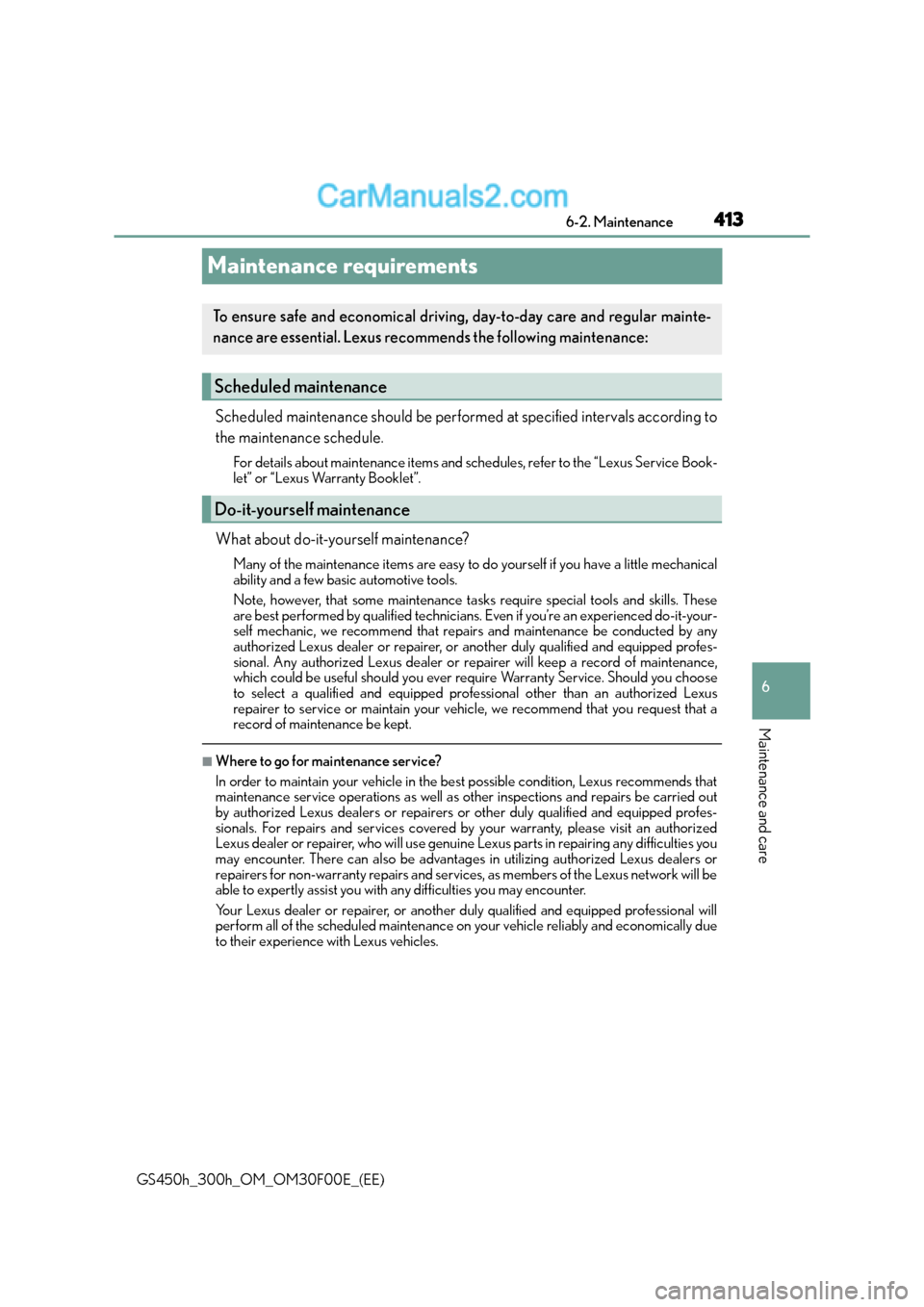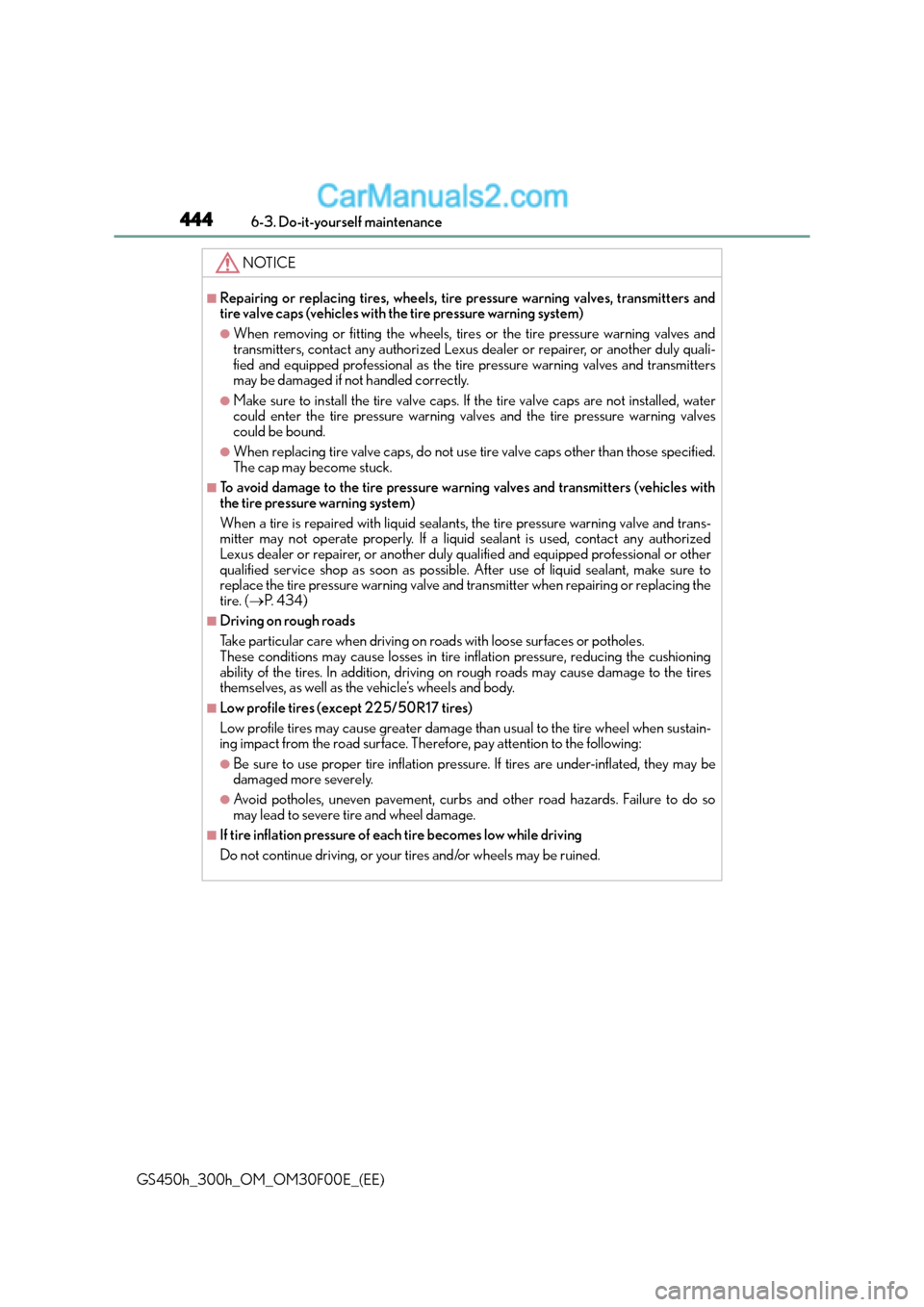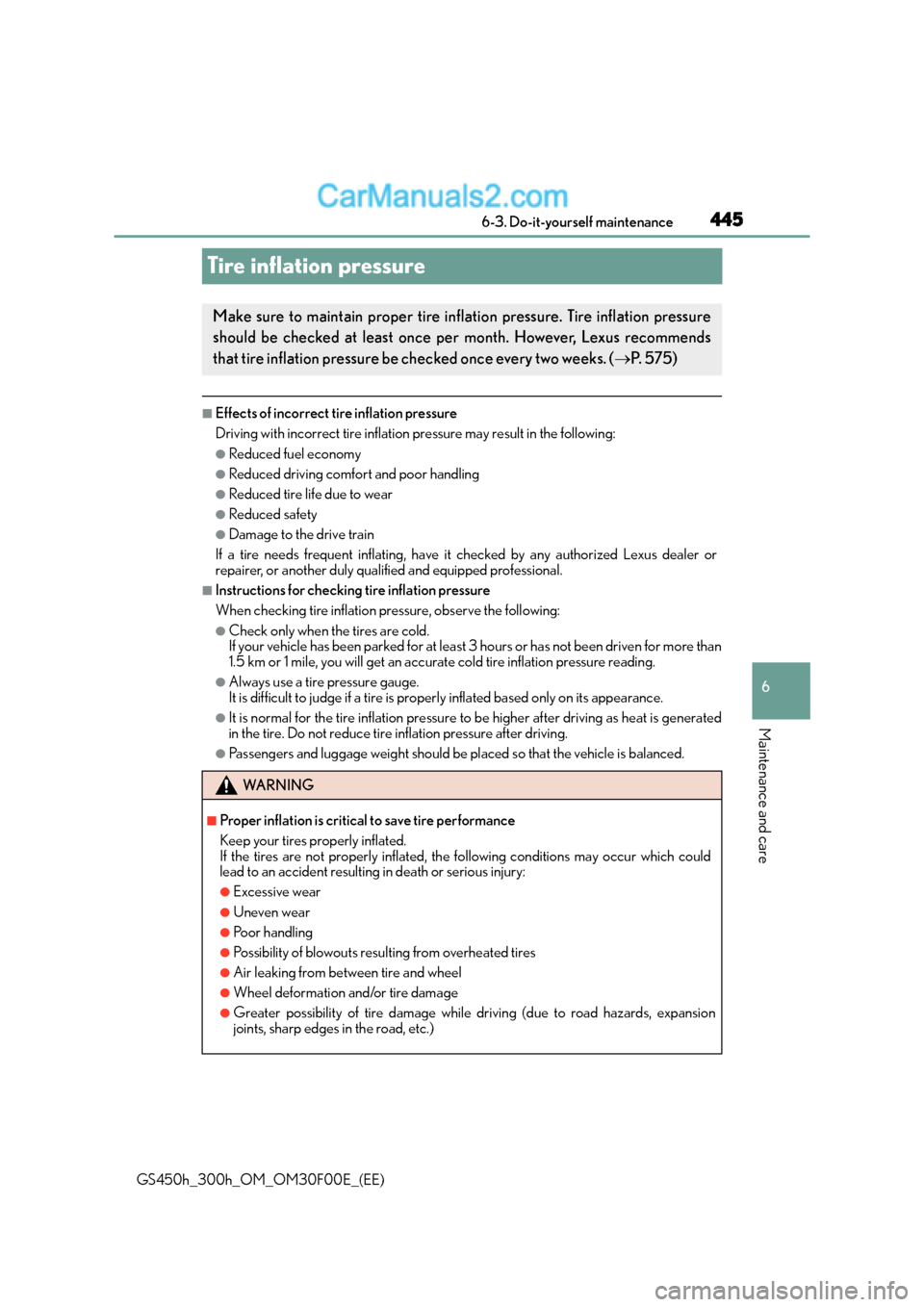2015 Lexus GS300h air condition
[x] Cancel search: air conditionPage 413 of 620

413
6
6-2. Maintenance
Maintenance and care
GS450h_300h_OM_OM30F00E_(EE)
Maintenance requirements
Scheduled maintenance should be performed at specified intervals according to
the maintenance schedule.
For details about maintenance items and sche
dules, refer to the “Lexus Service Book-
let” or “Lexus Warranty Booklet”.
What about do-it-yourself maintenance?
Many of the maintenance items are easy to do yourself if you have a little mechanical
ability and a few basic automotive tools.
Note, however, that some maintenance ta sks require special tools and skills. These
are best performed by qualified technicians. Even if you’re an experienced do-it-your-
self mechanic, we recommend that repairs and maintenance be conducted by any
authorized Lexus dealer or repairer, or another duly qualified and equipped profes-
sional. Any authorized Lexus dealer or re pairer will keep a record of maintenance,
which could be useful should you ever require Warranty Service. Should you choose
to select a qualified and equipped professional other than an authorized Lexus
repairer to service or maintain your vehicle, we recommend that you request that a
record of maintenance be kept.
■Where to go for maintenance service?
In order to maintain your vehicle in the best possible condition, Lexus recommends that
maintenance service operations as well as other inspections and repairs be carried out
by authorized Lexus dealers or repairers or other duly qualified and equipped profes-
sionals. For repairs and services covered by your warranty, please visit an authorized
Lexus dealer or repairer, who will use genuine Lexus parts in repairing any difficulties you
may encounter. There can also be advantag es in utilizing authorized Lexus dealers or
repairers for non-warranty repairs and services, as members of the Lexus network will be
able to expertly assist you with any difficulties you may encounter.
Your Lexus dealer or repairer, or another duly qualified and equipped professional will
perform all of the scheduled maintenance on your vehicle reliably and economically due
to their experience with Lexus vehicles.
To ensure safe and economical driving, day-to-day care and regular mainte-
nance are essential. Lexus recommends the following maintenance:
Scheduled maintenance
Do-it-yourself maintenance
Page 414 of 620

4146-2. Maintenance
GS450h_300h_OM_OM30F00E_(EE)
■Does your vehicle need repairs?
Be on the alert for changes in performance and sounds, and visual tip-offs that indicate
service is needed. Some important clues are:
●Engine missing, stumbling or pinging
●Appreciable loss of power
●Strange engine noises
●A fluid leak under the vehicle (However, water dripping from the air conditioning sys-
tem after use is normal.)
●Change in exhaust sound (This may indicate a dangerous carbon monoxide leak. Drive
with the windows open and have the exhaust system checked immediately.)
●Flat-looking tires, excessive tire squeal when cornering, uneven tire wear
●Vehicle pulls to one side when driven straight on a level road
●Strange noises related to suspension movement
●Loss of brake effectiveness, spongy feeling brake pedal, pedal almost touches the floor,
vehicle pulls to one side when braking
●Engine coolant temperature continually higher than normal ( →P. 1 0 5 )
If you notice any of these clues, take your vehicle to any authorized Lexus dealer or
repairer, or another duly qualified and equipp ed professional as soon as possible. Your
vehicle may need adjustment or repair.
WA R N I N G
■If your vehicle is not properly maintained
Improper maintenance could result in serious damage to the vehicle and possible
death or serious injury.
■Handling of the 12-volt battery
12-volt battery posts, terminals and related accessories contain lead and lead com-
pounds which are known to cause brain damage. Wash your hands after handling.
( → P. 4 2 8 )
Page 415 of 620

415
6
6-3. Do-it-yourself maintenance
Maintenance and care
GS450h_300h_OM_OM30F00E_(EE)
Do-it-yourself service precautions
If you perform maintenance by yourself, be sure to follow the correct proce-
dure as given in these sections.
ItemsParts and tools
12-volt battery
condition
(
→ P. 4 2 8 ) •Grease
• Conventional wrench (for terminal clamp bolts)
Engine/power
control unit coolant
level (
→P. 4 2 5 ) •“
To y o t a Super Long Life Coolant” or a similar high quality
ethylene glycol-based non-silicate, non-amine, non-nitrite
and non-borate coolant with long-life hybrid organic acid
technology
“Toyota Super Long Life Coolant” is pre-mixed with 50%
coolant and 50% deionized water.
• Funnel (used only for adding coolant)
Engine oil level
( → P. 4 2 2 )• “Toyota Genuine Motor Oil” or equivalent
• Rag or paper towel
• Funnel (used only for adding engine oil)
Fuses ( →P. 4 5 3 )• Fuse with same amperage rating as original
Light bulbs
(→ P. 4 5 8 )• Bulb with same number and wattage rating as original
• Phillips-head screwdriver•Flathead screwdriver
•Wrench
Radiator and
condenser
(→ P. 4 2 7 )
Tire inflation
pressure ( →P. 4 4 5 )• Tire pressure gauge• Compressed air source
Wa s h e r f l u i d
(→ P. 4 2 7 )• Water or washer fluid containing antifreeze (for winter use)
• Funnel (used only for adding water or washer fluid)
Page 416 of 620

4166-3. Do-it-yourself maintenance
GS450h_300h_OM_OM30F00E_(EE)
WA R N I N G
The engine compartment contains many mechanisms and fluids that may move suddenly,
become hot, or become electrically energized. To avoid death or serious injury, observe
the following precautions.
■When working on the engine compartment
●Make sure that the “POWER ON” on the multi-information display and the
“READY” indicator are both off.
●Keep hands, clothing and tools away from the moving fan and engine drive belt.
●Be careful not to touch the engine, power control unit, radiator, exhaust manifold, etc.
right after driving as they may be hot. Oil and other fluids may also be hot.
●Do not leave anything that may burn easily, such as paper and rags, in the engine
compartment.
●Do not smoke, cause sparks or expose an open flame to fuel. Fuel fumes are flamma-
ble.
●Take care because brake fluid can harm your hands or eyes and damage painted sur-
faces. If fluid gets on your hands or in your eyes, flush the affected area with clean
water immediately. If you still experience discomfort, consult a doctor.
■When working near the electric cooling fans or radiator grille
Be sure the power switch is off.
With the power switch in ON mode, the elec tric cooling fans may automatically start to
run if the air conditioning is on and/or the coolant temperature is high. ( →P. 4 2 7 )
■Safety glasses
Wear safety glasses to prevent flying or fallin g material, fluid spray, etc. from getting in
your eyes.
NOTICE
■If you remove the air cleaner filter
Driving with the air cleaner filter removed may cause excessive engine wear due to dirt
in the air.
■If the fluid level is low or high
It is normal for the brake fluid level to go down slightly as the brake pads wear or when
the fluid level in the accumulator is high.
If the reservoir needs frequent refilling, it may indicate a serious problem.
Page 436 of 620

4366-3. Do-it-yourself maintenance
GS450h_300h_OM_OM30F00E_(EE)
■When rotating the tires (vehicles with the tire pressure warning system featuring a tire
inflation pressure display function)
Make sure that the power switch is off. If the tires are rotated while the power switch is in
ON mode, the tire position information will not be updated.
If this accidentally occurs, either turn the power switch to off and then to ON mode, or
initialize the system after checking that the tire pressure is properly adjusted.
■Low profile tires (except 225/50R17 tires)
Generally, low profile tires will wear more rapidly and tire grip performance will be
reduced on snowy and/or icy roads when compared to standard tires. Be sure to use
snow tires or tire chains on snowy and/or icy roads and drive carefully at a speed appro-
priate for road and weather conditions. ( →P. 3 5 5 )
■If the tread on snow tires wears down below 4 mm (0.16 in.)
The effectiveness of the tire s as snow tires is lost.
■Situations in which the tire pressure warning system may not operate properly (vehi-
cles with the tire pressure warning system)
●In the following cases, the tire pressure warning system may not operate properly.
• If non-genuine Lexus wheels are used.
• A tire has been replaced with a tire that is not an OE (Original Equipment) tire.
• A tire has been replaced with a tire that is not of the specified size.
• Tire chains etc. are equipped.
• An auxiliary-supported run-flat tire is equipped.
• If a window tint that affects the radio wave signals is installed.
• If there is a lot of snow or ice on the vehicle, particularly around the wheels or wheel
housings.
• If the tire inflation pressure is extremely higher than the specified level.
• If wheel without the tire pressure warning valve and transmitter are used.
• If the ID code on the tire pressure warning valves and transmitters is not registered in the tire pressure warning computer.
●Performance may be affected in the following situations.
• Near a TV tower, electric power plant, gas station, radio station, large display, air-
port or other facility that generates strong radio waves or electrical noise
• When carrying a portable radio, cellular phone, cordless phone or other wireless communication device
Vehicles with the tire inflation pressure display function: If tire position information is
not correctly displayed due to the radio wave conditions, the display may be corrected
by driving and changing the radio wave conditions.
●When the vehicle is parked, the time taken for the warning to start or go off could be
extended.
●When tire inflation pressure declines rapidly for example when a tire has burst, the
warning may not function.
Page 444 of 620

4446-3. Do-it-yourself maintenance
GS450h_300h_OM_OM30F00E_(EE)
NOTICE
■Repairing or replacing tires, wheels, tire pressure warning valves, transmitters and
tire valve caps (vehicles with the tire pressure warning system)
●When removing or fitting the wheels, tires or the tire pressure warning valves and
transmitters, contact any authorized Lexus dealer or repairer, or another duly quali-
fied and equipped professional as the tire pressure warning valves and transmitters
may be damaged if not handled correctly.
●Make sure to install the tire valve caps. If the tire valve caps are not installed, water
could enter the tire pressure warning valves and the tire pressure warning valves
could be bound.
●When replacing tire valve caps, do not use tire valve caps other than those specified.
The cap may become stuck.
■To avoid damage to the tire pressure warning valves and transmitters (vehicles with
the tire pressure warning system)
When a tire is repaired with liquid sealants , the tire pressure warning valve and trans-
mitter may not operate properly. If a liquid sealant is used, contact any authorized
Lexus dealer or repairer, or another duly qu alified and equipped professional or other
qualified service shop as soon as possible. After use of liquid sealant, make sure to
replace the tire pressure warning valve and transmitter when repairing or replacing the
tire. ( →P. 4 3 4 )
■Driving on rough roads
Take particular care when driving on roads with loose surfaces or potholes.
These conditions may cause losses in tire inflation pressure, reducing the cushioning
ability of the tires. In addition, driving on rough roads may cause damage to the tires
themselves, as well as the vehicle’s wheels and body.
■Low profile tires (except 225/50R17 tires)
Low profile tires may cause greater damage than usual to the tire wheel when sustain-
ing impact from the road surface. Therefore, pay attention to the following:
●Be sure to use proper tire inflation pressure. If tires are under-inflated, they may be
damaged more severely.
●Avoid potholes, uneven pavement, curbs and other road hazards. Failure to do so
may lead to severe tire and wheel damage.
■If tire inflation pressure of each tire becomes low while driving
Do not continue driving, or your tires and/or wheels may be ruined.
Page 445 of 620

445
6
6-3. Do-it-yourself maintenance
Maintenance and care
GS450h_300h_OM_OM30F00E_(EE)
Tire inflation pressure
■Effects of incorrect tire inflation pressure
Driving with incorrect tire inflation pressure may result in the following:
●Reduced fuel economy
●Reduced driving comfort and poor handling
●Reduced tire life due to wear
●Reduced safety
●Damage to the drive train
If a tire needs frequent inflating, have it checked by any authorized Lexus dealer or
repairer, or another duly qualified and equipped professional.
■Instructions for checking tire inflation pressure
When checking tire inflation pressure, observe the following:
●Check only when the tires are cold.
If your vehicle has been parked for at least 3 hours or has not been driven for more than
1.5 km or 1 mile, you will get an accurate cold tire inflation pressure reading.
●Always use a tire pressure gauge.
It is difficult to judge if a tire is prop erly inflated based only on its appearance.
●It is normal for the tire inflation pressure to be higher after driving as heat is generated
in the tire. Do not reduce tire inflation pressure after driving.
●Passengers and luggage weight should be pl aced so that the vehicle is balanced.
Make sure to maintain proper tire inflation pressure. Tire inflation pressure
should be checked at least once per month. However, Lexus recommends
that tire inflation pressure be checked once every two weeks. ( →P. 5 7 5 )
WA R N I N G
■Proper inflation is critical to save tire performance
Keep your tires properly inflated.
If the tires are not properly inflated, the following conditions may occur which could
lead to an accident resulting in death or serious injury:
●Excessive wear
●Uneven wear
●Poor handling
●Possibility of blowouts resulting from overheated tires
●Air leaking from between tire and wheel
●Wheel deformation and/or tire damage
●Greater possibility of tire damage while driving (due to road hazards, expansion
joints, sharp edges in the road, etc.)
Page 449 of 620

449
6
6-3. Do-it-yourself maintenance
Maintenance and care
GS450h_300h_OM_OM30F00E_(EE)
Air conditioning filter
Turn the power switch off.
Open the glove box. Lift up the side
with the stay, disconnect the stay
tabs and remove the partition by
pulling horizontally.
Press the tabs and remove the filter
cover.
Press the tabs and remove the filter
case.
The air conditioning filter must be changed regularly to maintain air condi-
tioning efficiency.
Removal method
1
2
3
4